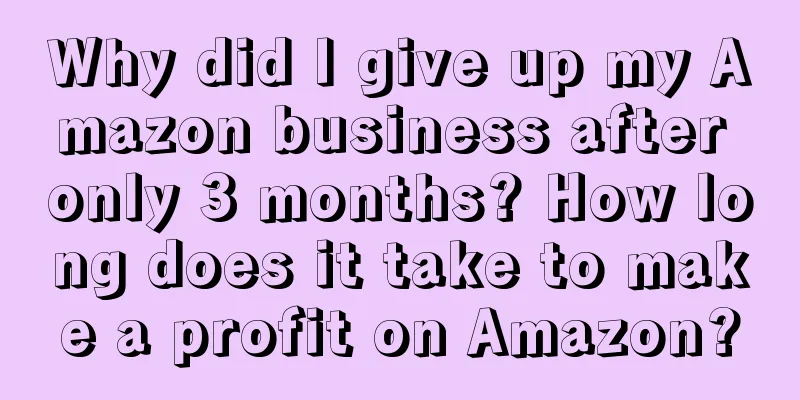Let’s have some dried dry goods: 3 ways to find potential incremental categories

It is an industry consensus that fast-moving consumer goods have entered the inventory era, but vitality can still be seen in various categories. For example, Oriental Leaves, Deyou Wet Toilet Paper, and PROYA have maintained year-on-year growth. How do they find opportunities in a market full of red oceans? How do they define new products after finding growth categories? And how do they quickly iterate on the right channel combination? From his own many 0 to 1 practical breakthroughs, Liu Ruizhi summarized this set of practical methodology and pitfall avoidance guide of "exploring categories - developing products - channel strategy". 01 Locking in new categories: How to find growth opportunities in the existing market?The era of scrambling for market share is over. Now most brands can only look for opportunities in the cracks of the ground. So how do you find opportunities in the cracks of the ground? Combining past experience in product innovation and business practice, I have summarized the following three methods for finding potential categories: First, look at the penetration rate and find the golden categories with a potential scale of more than 50 billion. First, in the large categories with category penetration > 30% and no sustained shrinkage, drill down to find the growing subcategories; If it is not suitable, you can look at categories with low penetration rates, but which have been growing rapidly for three consecutive years and have high penetration rates in target competitive categories and target scenarios. For example, wet toilet paper has a penetration rate of only 5% now, but the penetration rate of the target competitive category of paper towels is high. Second, look at changes in population structure and find new scenarios for the elderly. Where can we find the scenarios? In the next few decades, I urge everyone to pay more attention to the following groups:
Why? Because these people have a lot of free time. Once their disposable income increases, consumption demand will emerge. For this, the categories that are rising rapidly today will have a better experience. Bicycles are an example. In the past five to ten years, bicycle brands have basically been OEMs for shared bicycles. If brands had seen the scene demands generated by the future changes in the population a few years ago and laid out the road bicycle category in advance, they might be the only pigs in the wind today. Of course, road bicycles can also be made now, but the top players are mainly foreign brands, which are not so competitive, or their ability to compete is not as strong as that of domestic brands. But you have to be careful when creating new scenes for older people, as there will be pitfalls. Case Study 1: Pitfalls in New ScenariosSome of you here will remember that in 2016, many meal replacement powder and protein powder brands appeared. However, not many of them are still alive today. Because until 2021, only 10% of people went to the gym more than twice a month. They were trapped by this data. Here is a word of advice for everyone: For scenarios with a penetration rate of less than 30%, don’t make peripheral applications for them, but make mainstream applications. Otherwise, even if you make a lot of money today, it will be difficult to become a core category that defines a big brand in the future. Back to finding growth categories. Some friends said that there is a category that is shrinking continuously, such as soy milk and plant milk, which are now much lower than in the past. So how can we find growth categories in it? Third, look at the history of consumer goods in the United States and Japan to find the patterns of the rise and fall of product categories. First, draw four coordinate systems: the first is the ratio of average household expenditure on consumer goods to average household income; the second is category penetration rate; the third is the average unit price, and the fourth is consumption volume. Then, find the coordinates of China, the United States, Japan, and Europe in the four data dimensions, and see which historical periods overlap with other countries. How to “copy” after finding it? Look to the United States to predict the rise and fall of category structures, and look to Japan to learn details of product innovation. But be careful when copying. Everyone must have some questions, because some bosses like to copy from Japan, which is path dependence, but they must be cautious. How to understand? The United States is a country with a large population base, many ethnic groups, and a vast territory, which is very similar to China, while Japan is a country with a relatively small land area and a particularly high population density. Many business models may not appear in Japan. Let me give you an example that happens to me, such as coffee, a very popular category and track. Japan has a market of about 200 billion, but 50% of it is packaged coffee. Can you imagine that? But in the United States, packaged coffee only accounts for 8% or 9%, the same as in China. Why? First, Japan is small and there are not many places to open coffee shops; second, due to the high population density of the Japanese people, many business formats do not exist there, forcing Japanese brands to make a huge amount of innovation in packaged consumer goods. Case Study 2: Copying the latest products from other markets and importing them into ChinaIn 2014, two brands in our category copied the most popular products in the US market in 2008 and brought them to China. The first brand copied the product content, and the second brand copied the business model. They both failed because their strategies at that time were at least ten or even twenty years ahead of the market. Why do you say that? Let’s go back to our own case – Jane Eyre’s Second Curve: Fatherly Love Formula. In 2017, the entire yogurt category did not grow. However, Jane Eyre found PMF (Product Market Fit) and used the new category of Father’s Love Formula to increase the repurchase rate of the entire brand. At that time, we used the method of learning from history. First, we put the penetration rate, average price, per capita consumption, and average gross profit margin of low-temperature yogurt on the coordinate axis, and compared them with the United States and Japan one by one. The benchmarking found that the average price and gross profit margin of low-temperature yogurt in China in 2017 were equivalent to those in the United States in 1998, and the per capita consumption was equivalent to that in the United States in 2008, so you cannot bring in things from 2018. Seeing this, I believe everyone has a clearer sense of how the previous two brands are hanging up. After carefully studying the data, we found a very strange insight - the penetration rate of the US yogurt market increased by 45 points from 1998 to 2008. So we are thinking about which major categories are driving it? After research, we found three categories: one is low-burden yogurt, two is functional yogurt, and three is children's yogurt. Then Jane Eyre laid out, implemented, and implemented these three categories. Among them, the most well-known children's yogurt is Father's Love Formula. After two years of polishing, the Father's Love Formula was launched in 2019. In its first full year on the market, it achieved sales of 180 million, becoming the top-selling low-temperature dairy product of the year. So how did we land on the product from the children's yogurt category? 02 Defining new products: How to design differentiated products with barriersFirst, let’s talk about the definition of the product. I don’t think of a product as packaging + content. In my opinion, a product is a value proposition that consumers can recognize, feel, and afford. Tesla's first-generation car, Model X. We removed the Tesla brand halo and Musk's personality, and after a test drive, we could really feel that the new generation was smoother and more pleasant. In my opinion, this is an innovative and differentiated value proposition. Then everyone will ask, is it enough to brainstorm and find a feature or selling point that the competitor has not mentioned, or a technical feature that has never appeared in the world to differentiate it? Definitely not. How do you understand that? Taking Yuanqi Forest’s Yuanqi Water as an example, let us understand the three standards of cognizable, perceptible and affordable .
Although Yuanqi Water has encountered some problems today, its growth in the past few years has also verified the effectiveness of its differentiation. After all, the leap in consumers' health awareness is an uncontrollable factor that no one can predict. Here is also a negative example. Pitfall 3: New categories must have significant and perceptible differentiationI bought two brands of wet wipes from the market, one is wet toilet paper, and the other is wet wipes for babies and toddlers. I felt that they were similar, so I consulted a professional. The professional told me that there was a big difference between the two brands, the difference in water content, and the difference in the feeling of wiping the butt. But in my opinion, this is not enough differentiation. How to measure whether you have done enough differentiation? I will give you a sentence: Perceivable differentiation should be based on the standard of what straight science and engineering men can perceive. 80% of consumers cannot perceive the differentiation that bosses, brands, and R&D managers think of. How to find differentiation? 1. Become a newbie for a second and find out the underlying needs of major categories. Being able to become a novice in a second is the ability to tap into underlying needs. Internet product managers often say that if you become a novice in an hour, I advise you not to do this job because it means you are not suitable. Before developing a product, think about what problems your product will solve in what scenarios and what problems will arise when solving these problems. 2. Based on the population, find sub-categories within the large category demand. If you are creating subcategories within a large category, we need to segment our demand model based on the population. For example, when parents buy yogurt for their children, it is different from when Generation Z buys it for themselves. Parents focus on nutrition, especially for their children, but when Generation Z and the new generation buy it, they care about taste memory and convenience, not safety and digestive health. 3. Place the underlying needs in the four quadrants and find the most scarce differentiation.
There are many differentiations that can be found, but not all of them are useful; after finding them, use the three principles of "recognizable, perceptible, and affordable" to screen them. The following are some extreme differences selected from Father’s Love Formula:
Here are four principles for packaging differentiation.
After completing the first three steps, we usually find a dilemma: the product is differentiated, but consumers cannot afford it. This is when we need to do the fourth step. 4. Perform differentiated Pareto optimization. One point that needs careful attention is price. Generally speaking, if you have already charged a premium of more than 50% over the mid- to high-end brands in the target competitive category, you should be careful, as this exceeds a reasonable threshold. For example, although the Father's Love formula is 400% higher than traditional yogurt, its use is actually targeted at children's complementary foods. In this way, it is cheaper, so it doesn't matter. After defining the differentiation of the product, you still need to consider how to create barriers. There are two ways to create differentiated barriers: 1. The poor people’s approach. The "poor" first use cognitive design to iterate differentiation with scarcity, and then after it becomes bigger, they build a supply chain to upgrade it into differentiation with even greater scarcity barriers. How to understand it? Let’s take the Father’s Love Formula as an example. After Father’s Love Formula has grown to a certain scale and carried out preliminary verification, and it is found that the repurchase rate of the core group has increased, the differentiated point of being sugar-free and additive-free is upgraded to increase its scarcity: a scarcity barrier for the supply chain is created, and an unmanned factory is built. 2. What rich people do. First build scarcity and differentiation in a certain category, and then slowly iterate the cognition. This category is the rich taking up a position in a large category in advance. An example is Nongfu Spring, a hot new star in the business world. They are very capable. Even in a small track like Tanqi with a value of only one or two hundred million, they have already set up their own coffee roasting factory in advance, built up barriers, and are waiting for the wind to come. 03 Targeting new channels: 100% of resources are focused on first purchases, and 100% of energy is focused on repeat purchasesAfter locking in new categories and defining new products, it’s time to start fighting. Most people’s first reaction is to target bonus channels, but my specialty is not e-commerce, nor do I engage in special channels. So I want to talk about another method - 100% of resources are focused on first purchases, and 100% of energy is focused on product reuse frequency and repurchase rate. How to do it specifically? 1. Find the casual users and verify whether the reuse frequency is 200% higher than that of competitors? Jane Eyre found 3,000 parents to verify whether their children were willing to eat yogurt when eating complementary foods every day. No matter what new product you make, please find at least 100 zero-point people first to verify whether there are people who are willing to use your product every day. The zero-point crowd can be a private community or friends. 2. Find the original group of people and verify whether the repurchase rate is 200% higher than that of competitors? Father's Love Formula uses WeChat Moments ads, public accounts, and Tmall to find the original purchase group, and then check their repurchase rate. If the repurchase rate is not 200% higher than the target competitive category, don't go any further. 3. Continue to verify the repurchase rate of the core population and see whether the penetration rate of the segmented population is 30%? Father's Love Formula has been promoted on the ground to continue to verify the repurchase rate; at the same time, it is also verifying the penetration of the core population. If the penetration rate is greater than 30%, it can be widely penetrated in key channel combinations. 04 Summary and ReviewFinally, let’s review the main content of today. 1. Lock in new categories: To find a new incremental category in the existing market, you need to look at the penetration rate, population structure, and history of the United States and Japan. 2. Define new products: After locking in a new product category, how to design differentiation with barriers? First, we need to explore the underlying needs of the category and find blank links; then use the principles of cognition, perception, and affordability to test whether these differentiations are reliable; finally, from the birth to the decline of the product, find the right time to intervene in the life cycle to build scarcity in the supply chain. 3. Target new channels: Use 100% of resources to focus on first-time purchase channels and scenarios, but use 100% of your energy to focus on the frequency of product reuse and repurchase rate. I hope that everyone can discover new growth opportunities from today’s sharing, because opportunities dug out from cracks in the ground often create those century-old brands! |
<<: Why can Atour Hotel stand out from the fierce market competition?
>>: Labels VS data indicator system, this article explains it very clearly!
Recommend
The logic behind the growth of Dewu (Douyin) users
Dewu is a vertical brand of shoes and clothing tha...
Anti-fraud guide! Nine ways to falsify data
When doing data analysis, you have data to analyze...
From wild growth to "getting on the right track", the evolution of the short drama industry
The transformation of short plays from "rough...
618, how are the new consumer brands doing?
At the beginning of 2023, all topics surrounding c...
How much does it cost to list on Amazon? What does the cost include?
There are actually quite a lot of merchants openin...
How to get keywords on the first page of Amazon? Method introduction
There is one thing that Amazon merchants must lear...
What are the tips for setting up Amazon coupons? What are the uses of setting up?
The coupons on the Taobao platform correspond to c...
What should brands learn from Jia Ling to impress female users?
Have you seen "Hot and Spicy"? How did t...
One video gained a million followers. Can Liu Yexi and others get the "ticket" to the Metaverse?
With the development of technology and the advent ...
Recyclable jewelry live broadcasts are madly harvesting the elderly: crying while broadcasting, dozens of yuan of bracelets claim to be recycled for millions of yuan, and the anchor has more than 10 billion yuan in change
Recently, there are many people who are obsessed w...
What are the requirements for doing Shopee e-commerce? How to operate Shopee?
In fact, there are still many people who are engag...
What should official accounts do in 2023?
Should you give up your WeChat account? Maybe you ...
What is the difference between Amazon's parent ASIN and child ASIN? What is the difference between them and SKU?
On the Amazon platform, we often come across two t...
Amazon opens Buy with Prime service to all merchants in the US
Amazon recently announced that it will open its Bu...
How to open a store on the Wish platform? What preparations should be made before opening a store?
As a world-renowned e-commerce platform, Wish prov...









